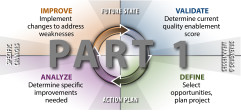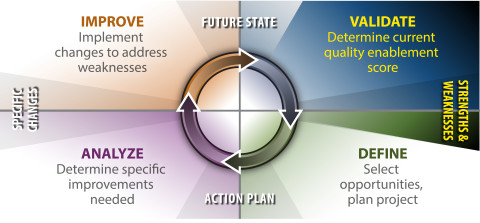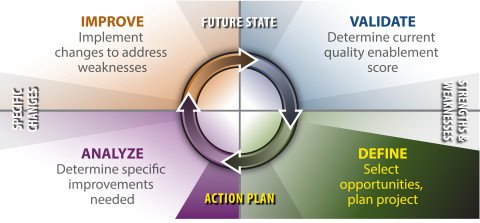… Is Implemented With a Plan (Part 1)

“There is nothing more difficult to take in hand, more perilous to conduct, or more uncertain in its success, than to take the lead in the introduction of a new order of things. Because the innovator has for enemies all those who have done well under the old conditions, and lukewarm defenders in those who may do well under the new.
Niccolo Machiavelli
We’re about halfway through our knowledge-transfer journey. The prior eight blog entries covered the framework and dimensions. Now we transition to the implementation components – given the dimensions and their interactions (the “edges”), how do we use that information to determine an organization’s current Quality Enablement status (the QE Score), use those result to identify the best opportunities, determine the changes needed, and implement those changes. I expect these discussions to take us into September.
In order to keep the weekly blogs in consistent, bite-sized chunks, we’ll be covering the implementation cycle in this week’s and next week’s entries.
QE Cycle – Part 1
The Quality Enablement (QE) Cycle has four phases, similar to the Shewhart Cycle, made famous primarily by W. Edwards Deming. One key aspect of both is that they are cycles, which can be repeatedly used until the desired results are achieved, starting with the most important opportunities and then continuing with the others until satisfied.
Each phase has the following components:
- Initialization activities;
- Processes and tools that are used to achieve a set of deliverables;
- Deliverables that set up the next phase; and
- Checkpoints that allows management to determine whether to move to the next phase or not.
Before we can start the project, we need the following:
- Project Sponsor – This is the senior executive who manages the organization in question. He/She needs to fully and visibly support the effort, provide support for the teams throughout the process, and will chair the checkpoint meetings.
- Project Leader – This individual needs to be fully allocated to the project, without significant distractions from other projects or departmental demands.
- Checkpoint Committee – At the end of each phase, the Project Leader will present the status to the Checkpoint Committee, a group that is chaired by the Sponsor and typically includes other managers with leadership responsibility for the groups impacted.
Let’s look at each phase in a little more detail. We’ll start with Validate, the first phase in the cycle.
Validate

The primary objective of the Validate phase is to determine the QE Score. This is where we use the Subject Areas and Discussion Points that we reviewed with each Dimension.
- Initialization –
- The Sponsor needs to understand the overall process, and buy into that process. He/She also needs to be aware that one of the findings could be that the Management Style is a major inhibitor, and that typically points back to him/her, or other members of the leadership team. If that is a finding that will not be accepted, I would recommend abandoning the project (and possibly looking for a job elsewhere).
- In order to get an accurate QE Score, we need to interview the right people. There is no magic formula, since this process can work for almost any type of organization or department. But a list of 20-25 should work for most organizations. And they need to represent the key teams / departments. The Sponsor and Project Leader are responsible for identifying those individuals.
- The Sponsor informs the organization about the project, and clearly communicates his/her commitment to it. In that communication, which can be a meeting, email, or other method, it must be made clear to all that the Project Leader will not share any of the personally attributable interview information with the Sponsor (an anyone else, for that matter).
- Processes and Tools – Each person identified is interviewed 1:1, using the Subject Area Discussion Points. I would plan these meetings for an hour each, but allow 90 minutes if the discussion runs over. Each response is scored, and the individual scores are aggregated into an overall QE Score. The details of the QE Score workbook will be covered in a future blog entry.
- Deliverables – The QE Score will identify strengths and opportunities, at both the Dimension and Subject Area levels. And the general business value of moving from inhibiting to enabling needs to be identified. We will get a more accurate business value in the Analyze phase. There is a potential for a political issue here, if the opportunity relates to Management Style. This will often point to the Sponsor, who may feel threatened.
- Checkpoint – The Checkpoint Committee review the deliverables and determine if there is sufficient value to move to the Define phase. If the decision is made to move forward, the initial target opportunities are usually selected.
Define

Here we select the target opportunities, if that wasn’t done at the prior checkpoint, and plan the project.
- Initialization – Given the targeted opportunities, the project team will most likely need to be expanded. And the Sponsor will need to ensure that the new team members have their current responsibilities adjusted to allow them to work on the project.
- Process and Tools – This is like any other project, and the typical project planning processes and tools are used. Your choice will likely be driven by the organization’s project lifecycle (PLC); while the deliverables listed below reflect a six sigma life cycle, the same information should be included in alternate project artifacts.
- Deliverables –
- Project Charter, including business case, objective(s), scope and team members
- Project Schedule
- Stakeholder Analysis
- Communication Plan
- Risk Analysis
- Checkpoint – The Checkpoint Committee review the deliverables and determine whether the project moves ahead as defined, is modified (usually in scope), or is cancelled.
What’s Next
Next week, we’ll pick up where we left off, and cover the next two phases of the QE Cycle – Analyze and Improve.
Until Then …
“Things do not happen. Things are made to happen.
John F. Kennedy

What are your thoughts? Please share your comments in the block below.